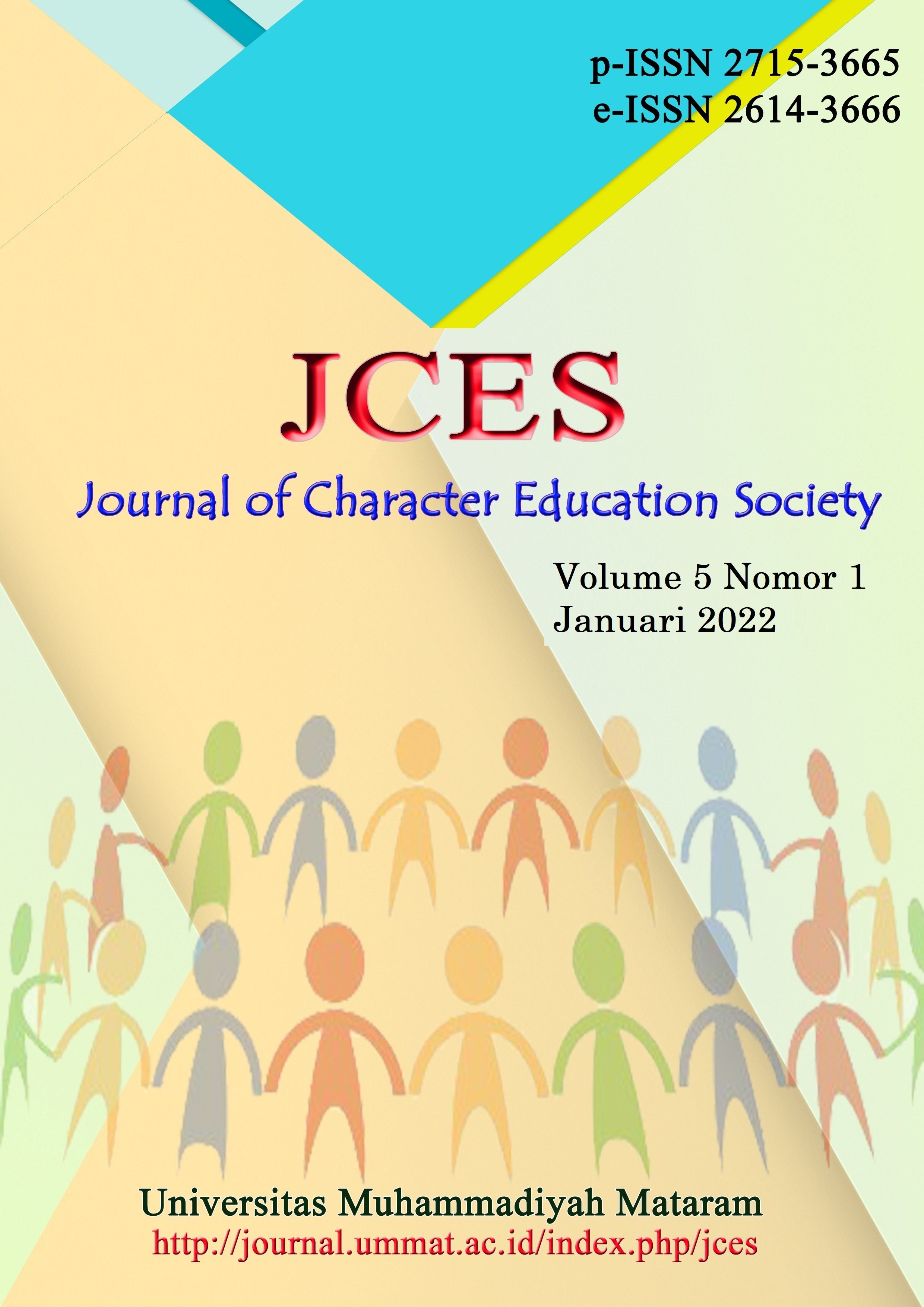PELATIHAN PERCAKAPAN BAHASA JEPANG MELALUI MEDIA VIDEO DALAM PEMBELAJARAN DARING DI SMK KESEHATAN SADEWA
DOI:
https://doi.org/10.31764/jces.v5i1.6664Keywords:
Japanese Language, Nurse, Video, OnlineAbstract
Abstrak: Pada tahun 2017 pemerintah Jepang dengan pemerintah Indonesia sudah membuat perjanjian IJEPA terutama dalam bidang kesehatan dengan mengirimkan perawat dari Indonesia untuk bekerja sebagai perawat di Jepang. Perawat yang diperlukan oleh pemerintah Jepang tidak hanya perawat lulusan S1 dan D3. Bahkan perawat yang berasal dari SMK Kesehatan pun mempunyai peluang pekerjaan yang sama. Untuk menghadapi peluang tersebut SMK Kesehatan menjawab dengan memasukan mata pelajaran bahasa Jepang ke dalam kurikulumnya baik untuk kegiatan intrasekolah maupun ekstrasekolah. Dalam kondisi Pandemi saat ini dimana pembelajaran semua dilaksanakan secara online sehingga sangat penting memilih media yang digunakan. Tujuan dari pengabdian ini adalah untuk melatih kemampuan Bahasa Jepang siswa SMK Kesehatan Sadewa dan untuk mengetahui respons siswa setelah mendapatkan pelatihan. Pelatihan dilaksanakan dua kali pada tanggal 21 dan 23 Juli 2021 dengan peserta 25 siswa SMK Kesehatan Sadewa kelas XII Asisten Keperawatan 3. Pelatihan dilaksanakan dengan materi penjelasana manfaat video pembelajaran, Kosakata dan pola kalimat Bahasa Jepang. Berdasarkan survei yang dibagikan kepada peserta. Peserta merasa media dan materi yang disampaikan menarik dan sangat bermanfaat.Â
Abstract:Â In 2017 the Japanese government and the Indonesian government had made an IJEPA agreement, especially in the health sector, by sending nurses from Indonesia to work as nurses in Japan. Nurses needed by the Japanese government are not only nurses who graduate from S1 and D3. Even nurses from Health Vocational Schools have the same job opportunities. The Health Vocational School responded by incorporating Japanese subjects into its curriculum for both Intra-school and extra-school activities to face this opportunity. In the current Pandemic conditions where all learning is carried out online, it is essential to choose the media used. This service aims to train the Japanese language skills of the Sadewa Health Vocational School students and to find out the student's response after receiving the training. The training was conducted twice on 21 and 23 July 2021 with 25 Sadewa Health Vocational School class XII Nursing Assistant 3. The training was carried out with material explaining the benefits of learning videos, Japanese vocabulary, and sentence patterns. Based on the survey distributed to participants. Participants felt that the media and materials presented were exciting and very useful.
References
Agistiawati, E. (n.d.). PENGARUH PERSEPSI SISWA ATAS LINGKUNGAN BELAJAR DAN PENGUASAAN KOSAKATA TERHADAP KEMAMPUAN BERBICARA BAHASA INGGRIS SISWA SEKOLAH MENENGAH ATAS SWASTA BALARAJA.
Anugrahana, A. (2020). Hambatan, Solusi dan Harapan: Pembelajaran Daring Selama Masa Pandemi Covid-19 Oleh Guru Sekolah Dasar. Scholaria: Jurnal Pendidikan Dan Kebudayaan, 10(3). https://doi.org/10.24246/j.js.2020.v10.i3.p282-289
Astami, T. S. (2015). Model Pembelajaran Kaiwa Tingkat Dasar Sesuai dengan JF Standar. LINGUA CULTURA, 9(2), 96–99.
Batubara, H. H., & Ariani, D. N. (2016). Pemanfaatan Video sebagai Media Pembelajaran Matematika SD/MI. Muallimuna : Jurnal Madrasah Ibtidaiyah, 2(1). https://doi.org/10.31602/muallimuna.v2i1.741
Daryanto, J. (n.d.). PENGGUNAAN MEDIA PEMBELAJARAN VIDEO INTERAKTIF UNTUK MENINGKATKAN PEMAHAMAN TEMBANG MACAPAT DALAM PEMBELAJARAN BAHASA DAERAH PADA SISWA SEKOLAH DASAR.
Fara, A., Putri, Z., Lamijan, D. H., Susarno, H., & Pd, M. (n.d.). PENGEMBANGAN MEDIA PEMBELAJARAN VIDEO ANIMASI MATA PELAJARAN BAHASA JEPANG MATERI TEMA KEHIDUPAN KELUARGA UNTUK KELAS XI DI SMA NEGERI 1 MOJOSARI MOJOKERTO.
Istiqomah, D., Diner, L., Kusumah Wardhana, C., Bahasa, J., Asing, S., Bahasa, F., & Seni, D. (2015). Journal of Japanese Learning and Teaching ANALISIS KESULITAN BELAJAR BAHASA JEPANG SISWA SMK BAGIMU NEGERIKU SEMARANG. In CHI’E (Vol. 4, Issue 1). http://journal.unnes.ac.id/sju/index.php/chie
Kharismawati, M., & al Hakimi, I. M. (2021). Penggunaan Kosanoge Melalui Media WhatsApp dalam Pembelajaran Bahasa Jepang Di SMK Kesehatan Sadewa Yogyakarta. JLA (Jurnal Lingua Applicata), 4(2), 135. https://doi.org/10.22146/jla.64714
Maisyarah Ammy, P., & Wahyuni, S. (2020). ANALISIS MOTIVASI BELAJAR MAHASISWA MENGGUNAKAN VIDEO PEMBELAJARAN SEBAGAI ALTERNATIF PEMBELAJARAN JARAK JAUH (PJJ). 1, 27–35. https://doi.org/10.36294/jmp.vxix.xxx
Saharsa, U., Qaddafi, M., Pendidikan Fisika, B., Tarbiyah dan Keguruan, F., & Alauddin Makassar, U. (2018). EFEKTIVITAS PENERAPAN MODEL PEMBELAJARAN PROBLEM BASED LEARNING BERBANTUAN VIDEO BASED LABORATORY TERHADAP PENINGKATAN PEMAHAMAN KONSEP FISIKA. Jurnal Pendidikan Fisika, 6(2). http://journal.uin- alauddin.ac.id/indeks.php/PendidikanFisika
Setiawan, S. (2012). Analisis Dampak IJEPA. Jurnal Ilmiah Ekonomi Bisni, 17(2).
Sudrajat, J., & Rakian, S. (2020). PENGABDIAN KEPADA MASYARAKAT (PKM) PERCAKAPAN BAHASA JEPANG BAGI GENERASI MUDA DI PANIKI DUA MANADO. ABDIMAS: JURNAL PENGABDIAN KEPADA MASYARAKAT, 13(1). https://doi.org/10.36412/abdimas.v13i1.2143
Syaparuddin, S., & Elihami, E. (n.d.). PENINGKATAN MOTIVASI BELAJAR SISWA MELALUI VIDEO PADA PEMBELAJARAN PKn DI SEKOLAH PAKET C.
Widodo, A. (n.d.). PROBLEMATIKA PEMBELAJARAN DARING DALAM PERSPEKTIF MAHASISWA. https://doi.org/10.30651/else.v4i2.5340
Downloads
Published
Issue
Section
License
Authors who publish articles in JCES (Journal of Character Education Society) agree to the following terms:
- Authors retain copyright of the article and grant the journal right of first publication with the work simultaneously licensed under a CC-BY-SA or The Creative Commons Attribution–ShareAlike License.
- Authors are able to enter into separate, additional contractual arrangements for the non-exclusive distribution of the journal's published version of the work (e.g., post it to an institutional repository or publish it in a book), with an acknowledgment of its initial publication in this journal.
- Authors are permitted and encouraged to post their work online (e.g., in institutional repositories or on their website) prior to and during the submission process, as it can lead to productive exchanges, as well as earlier and greater citation of published work (See The Effect of Open Access).

